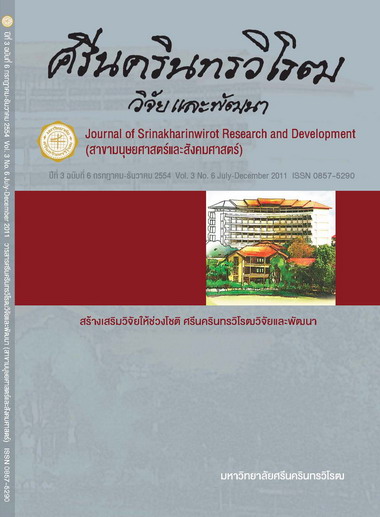การสวดสรภัญญะของจังหวัดนครพนม: ศึกษาตามแนวชาติพันธุ์วรรณนาแห่งการสื่อสาร (SARAPHANYA NAKHONPHANOM: AN ETHNOGRAPHY OF COMMUNICATION APPROACH)
Keywords:
Saraphanya prayer, An Ethnography of CommunicationAbstract
บทคัดย่อ การวิจัยนี้มีจุดมุ่งหมายเพื่อวิเคราะห์โครงสร้างของสถานการณ์สื่อสารในการสวดสรภัญญะและวิเคราะห์องค์ประกอบของเหตุการณ์สื่อสารต่างๆ ในการสวดสรภัญญะ ผลการศึกษาพบว่า สถานการณ์สื่อสารการสวดสรภัญญะของจังหวัดนครพนม ประกอบด้วยเหตุการณ์สื่อสารทั้งหมด 9 เหตุการณ์ ตามลำดับ ได้แก่ เหตุการณ์สื่อสารการทักทาย พิธีเปิดการสวดสรภัญญะ การแนะนำ การแสดงความสามารถของคณะกรรมการ การสวดสรภัญญะ การให้รางวัล การค้นหาดาวเสียง การให้รางวัลดาวเสียง และพิธีปิดการสวดสรภัญญะ ซึ่งการแยกเหตุการณ์สื่อสารดังกล่าว ผู้วิจัยใช้วัตถุประสงค์เป็นเกณฑ์
จากการวิเคราะห์องค์ประกอบของเหตุการณ์สื่อสาร สรุปภาพรวมได้ว่า ผู้ร่วมเหตุการณ์สื่อสารหลักของการสวดสรภัญญะ ประกอบด้วย พิธีการ คณะกรรมการ คณะผู้สวดสรภัญญะ พระสงฆ์ แขกผู้ทรงคุณวุฒิ ผู้ชมผู้ฟัง และผู้รับชมรับฟังที่อยู่ทางบ้าน สถานที่ของเหตุการณ์สื่อสารคือ ศาลาตรีมุข และศาลาพระธรรมราชานุวัตร วัดพระธาตุพนมวรมหาวิหาร จังหวัดนครพนม ซึ่งสถานที่ในการดำเนินงานได้จัดแบ่งส่วนต่างๆ แก่ผู้ร่วมเหตุการณ์อย่างชัดเจน เวลาในการดำเนินงานการสวดสรภัญญะ คือ 09.00 น. ถึง 16.00 น. เหตุการณ์สื่อสารทั้งหมดจัดเป็น 3 ส่วน ได้แก่ ส่วนนำ ส่วนเนื้อหา และส่วนสรุป หัวข้อหลักของการสวดสรภัญญะคือ การแสดงความเคารพ ความศรัทธาต่อคุณพระศรีรัตนตรัย วัตถุประสงค์หลักคือ เพื่อเพิ่มความเชื่อ ความศรัทธาต่อพระพุทธศาสนา ยกระดับจิตใจให้ดีขึ้น และสืบสานวัฒนธรรมท้องถิ่น เนื้อหาของเหตุการณ์สื่อสารคือ สวดสรภัญญะเพื่อจรรโลงใจผู้ฟัง ให้เนื้อหาของกลอนสวดขัดเกลาจิตใจ และถ่ายทอดคำสอนของพระพุทธศาสนาให้เข้าถึงผู้ชมผู้ฟังได้ง่าย และเพิ่มความศรัทธา ความเคารพต่อพระรัตนตรัยในทุกเหตุการณ์สื่อสาร มีการใช้ภาษาไทยมาตรฐาน ภาษาไทยถิ่นอีสาน และอวัจนภาษาต่างๆ ประกอบ การสื่อสารในเหตุการณ์สื่อสารปรากฏวัจนกรรมสื่อสารจำนวน 19 วัจนกรรม ได้แก่ แสดงความเคารพ การทักทาย การอธิบาย การขอบคุณ การขอร้อง การกล่าวนำ การกล่าวตาม การแนะนำ การชี้แจงกฎเกณฑ์ การกล่าวเชิญ การไหว้ครู การอวยพร การสั่งสอน แจ้งให้ทราบ การแสดงความสามารถ การสั่ง การตัดบท การประกาศผลการตัดสิน และการขอพร ซึ่งวัจนกรรมเหล่านี้เกิดสลับกันได้ และผู้วิจัยพบว่า วัจนกรรมการกล่าวนำเป็นวัจนกรรมที่เด่นที่สุดในเหตุการณ์สื่อสารทั้งหมด กฎการปฏิสัมพันธ์ที่ปรากฏในการสื่อสารแบ่งออกเป็นกฎทางพิธีกรรม การกล่าวข้อความ การถาม-ตอบของผู้ร่วมเหตุการณ์ และผู้วิจัย นำกฎดังกล่าวมาเป็นบรรทัดฐาน การตีความได้ว่า สังคมชนบทให้ความสำคัญ ความเคารพ ศรัทธาต่อคุณพระศรีรัตนตรัย เห็นได้จากการสืบสานวัฒนธรรมท้องถิ่นที่มีการดำเนินงานควบคู่ไปกับการ ทำนุบำรุงศาสนา และขัดเกลาจิตใจของคนในสังคม ด้วยการปรับคำสอนของศาสนาที่เข้าใจยากให้มีความเข้าใจและเข้าถึงคนในสังคมได้ง่ายขึ้น
Abstract
The objectives of this study were to analyze the structure of communication events and the component of communication events in Saraphanya. The results of the study were found that the communication events in Saraphanya Nakhonphanom consisted of 9 communication events in orderly: greeting communication events in Saraphanya opening ceremony, introduction, the committee’s ability performance, Saraphanya prayer, giving prizes looking for people who can pray Saraphanya well, giving prizes for people who can pray Saraphanya well and the Saraphanya closing ceremony which were separated by objective’s rules.
From analysing the communication event component, it can be concluded in overall image that, people who cooperated in the Saraphanya communication event were the master of the ceremony, the committee’s the Saraphanya prayer group, the monks, the qualified guests, the audience at the ceremony and the audience at home. The place of the communication event were three porch pavilion and Phra Dhammarachanuwat pavilion. That Phanom temple, Nokhonphanom province. The places were separated into parts obviously for participants. The procedure time was between 9:00 A.M.-4:00 P.M. There were 3 parts of communication event; introduction, contents and conclusion. The topics of Saraphanya were to pay respect and to show the faith to the Three Refuges. The main objectives were to increase the faith in Buddhism, to raise moral and to preserve local culture. The contents of the communication event were prayer to encourage the audience and let the content refine one’s mind and transmit the Lord Buddha’s teachings to the audience in this easier way, including increase the faith and respect to the Three Refuges. In every communication events, standard Thai language and northeastern Thai language was used and nonverbal languages consisted in the communication. In communication events appeared 19 communicative acts; respecting, greeting, explanation, thanking, asking, saying before, saying follow, introduction, clarify the rules, invitation, invocation, blessing, edifying, notice, ability, commanding, sampling and cut short, announcement of decision, asking for blessing. These acts were interchangeable and the researcher found that the say beforehand speech was the most outstanding among all communication events. The rules of interaction appeared in the communication were separated into the rules in ceremony, saying wording and asking-answering of the participants. The researcher brought these rules to be guideline for norms of interaction and interpretation and found that rural area society admitted the important, respecting and faith to the Three Refuges. We can see from their preserving local culture along with supporting religious and refining the people’s mind in their society by adapting the religious teaching which are difficult to easier understand and to reach people in society.
Downloads
Downloads
Published
How to Cite
Issue
Section
License
Srinakharinwirot Research and Development Journal of Humanities and Social Sciences is licensed Under a Creative Commons Attribution-NonCommercial-NoDerivs 4.0 International (CC-BY-NC-ND 4.0) License, Unless Otherwise Stated. Please Read Journal Policies Page for More Information on Open Access, Copyright and Permissions.



